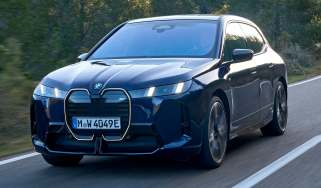Mercedes G-Class - MPG, CO2 and Running Costs
Every version of the Mercedes G-Class will be expensive to buy and run, especially the G 63

Life with a Mercedes G-Class is expensive even before you’ve left the showroom, so the running costs are unlikely to come as a shock. Even with all petrol and diesel engines gaining mild-hybrid technology to boost fuel economy, the G-Class still feels like a bit of a dinosaur. A loveable dinosaur, but a prehistoric one all the same.
The G 450 d starts from a not insignificant £137,000, but the G 500 comes in at £146,000, and the G 63 weighs in close to £184,500. And the costs won’t stop there.
In the G 450 d, its mild-hybrid tech has boosted fuel economy up to 31.4mpg, but both petrol versions are significantly more thirsty. The G 500 has a combined figure of 25mpg, although we saw close to 30 mpg from it on a gentle motorway run. The G 63 is undoubtedly the thirstiest model in the G-Class range, with an economy figure of just 19.1mpg – or worse if you enjoy yourself.
No version of the G-Class is what you’d call efficient, but the G-Class wasn’t built with efficiency or aerodynamics in mind. However, some tweaks to its shape, including a spoiler above the windscreen, a redesigned A-pillar, and a lip spoiler below the bumper have reduced its drag coefficient from a pre-facelift figure of 0.53Cd down to 0.48Cd.
| Model | MPG | CO2 | Insurance group |
| G-Class G 500 | 25.0mpg | 257g/km | 50P |
| Mercedes-AMG G 63 4MATIC | 19.1mpg | 338g/km | 50P |
| G-Class G 450d | 31.4mpg | 235g/km | 50P |
Electric range, battery life and charge time
The latest G-Class has joined the world of electric vehicles with the G 580 with EQ technology. That’s quite a lengthy name.
Used - available now

2024 Mercedes
G Class
11,500 milesAutomaticPetrol4.0L
Cash £162,000
2024 Mercedes
G Class
29,400 milesAutomaticPetrol4.0L
Cash £132,000
2024 Mercedes
G Class
54,000 milesAutomaticPetrol4.0L
Cash £109,950
2024 Mercedes
G Class
14,000 milesAutomaticDiesel2.9L
Cash £116,000Also big is its battery pack that, at 116kWh of usable capacity, affords a range of 280 miles between charges. It can accept a peak charging speed of 200kW, allowing for a 10 to 80 per cent top-up charge in around 32 minutes from a suitably rapid DC charger.
Most EV owners will likely utilise much more affordable home charging, of which Mercedes only quotes an 11kW AC time of around 12 hours to fully top up a G 580 from flat to full. However, that would require a three-phase electricity supply, which few UK houses can accommodate, so we anticipate that a more common 7.4kW home wallbox charger will take around 16 hours to recharge the car.
| Model | Battery size | Range | Insurance group |
| G-Class G 580 with EQ technology | 116kWh (useable) | 280 miles | 50P |
Tax
High CO2 emissions make the G-Class tax inefficient for private and company-car users, the latter of which will be stuck in the highest 37 per cent Benefit-in-Kind (BiK) tax band – although we’re unsure whether any company-car scheme would offer such a model to its employees.
The electric G 580 would be in a much more affordable two per cent band (rising to three per cent for the 25/26 tax year), but again, we doubt a company-car scheme would offer a near-£155,000 EV to staff.
Insurance groups
Make sure you’re sitting down when you use a price-comparison site to sort insurance quotes for the G-Class, because the cost will likely be very high. All versions are in the highest insurance group of 50, placing the G-Class alongside supercars and other luxury cars.
Depreciation
Depreciation is unlikely to bother a G-Class owner, because sales in the UK are modest, and it has a cult status, so its residual values are quite high. Most versions are in the region of 60 per cent, making the G-Class one of the best performers on the market. The Mercedes-AMG G 63 Carbon Edition is expected to hold on to 68 per cent of its original value after three years or 36,000 miles, according to our expert data. The electric G 580 with EQ technology is the worst-performing version, at 58 per cent, but that’s still a lot better than most electric cars.
However, when a new car costs well north of £100,000 (nearer £200,000 in some cases), you will still lose a considerable sum of money in depreciation.
To get an accurate valuation for a specific model, check out our valuation tool...











